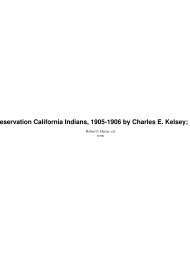Restoring a Bridge to the Past - Yosemite Online
Restoring a Bridge to the Past - Yosemite Online
Restoring a Bridge to the Past - Yosemite Online
Create successful ePaper yourself
Turn your PDF publications into a flip-book with our unique Google optimized e-Paper software.
PHOTO COURTESY OF CRAIG STRUBLE.<br />
Preservation specialists test fit bridge brace in<strong>to</strong> transverse beam<br />
during <strong>the</strong> 2002-2003 repairs.<br />
of 1955 that caused major damage, park engineers<br />
inspected <strong>the</strong> bridge and declared it “mortally wounded.”<br />
They concluded that <strong>the</strong> bridge probably couldn’t<br />
support its own weight, and recommended (with <strong>the</strong><br />
support of NPS Direc<strong>to</strong>r Conrad Wirth) that <strong>the</strong> old<br />
bridge be destroyed and replaced. But heavy lobbying by<br />
<strong>Yosemite</strong>’s Superintendent John Pres<strong>to</strong>n resulted in <strong>the</strong><br />
decision <strong>to</strong> rehabilitate, ra<strong>the</strong>r than remove, <strong>the</strong> structure<br />
because of its his<strong>to</strong>ric significance.<br />
Using an “ingenious” system of cables and pulleys,<br />
<strong>the</strong> bridge was pulled <strong>to</strong> <strong>the</strong> north bank of <strong>the</strong> river.<br />
After <strong>the</strong> bridge’s original design was carefully assessed<br />
and recorded, <strong>the</strong> structure was rebuilt and pulled back<br />
<strong>to</strong> its original position on <strong>the</strong> river. Not all parts of <strong>the</strong><br />
original span could be saved. In fact, fourteen bundles<br />
of dynamite were de<strong>to</strong>nated inside <strong>the</strong> bridge <strong>to</strong> remove<br />
<strong>the</strong> old shingles, which were replaced with similar handcrafted<br />
ones. New materials were carefully manufactured<br />
<strong>to</strong> match <strong>the</strong> originals, including <strong>the</strong> square nails holding<br />
it <strong>to</strong>ge<strong>the</strong>r.<br />
According <strong>to</strong> Craig Struble, NPS project manager for<br />
<strong>the</strong> 2002 res<strong>to</strong>ration, <strong>the</strong> effort <strong>to</strong> save <strong>the</strong> bridge in 1957<br />
showed great foresight. “It’s amazing,” Struble said, “that<br />
so much care was taken in <strong>the</strong> res<strong>to</strong>ration of <strong>the</strong> bridge<br />
during an era when <strong>the</strong> preservation ethic was much less<br />
developed than it is <strong>to</strong>day.”<br />
At <strong>the</strong> same time a decision was made <strong>to</strong> move sev-<br />
4<br />
Y O S E M I T E A S S O C I A T I O N , F A L L 2 0 0 4<br />
Scaffolding shrouds <strong>the</strong> bridge.<br />
eral his<strong>to</strong>rical structures from around <strong>the</strong> park <strong>to</strong> <strong>the</strong><br />
north side of <strong>the</strong> bridge <strong>to</strong> create <strong>the</strong> Pioneer <strong>Yosemite</strong><br />
His<strong>to</strong>ry Center. The PYHC was opened in 1962 and<br />
dedicated in 1964, <strong>the</strong> year of <strong>the</strong> 100 th anniversary of <strong>the</strong><br />
creation of <strong>the</strong> <strong>Yosemite</strong> Grant.<br />
RECENT REPAIRS<br />
In 2002, <strong>the</strong> Heritage Structural Team had <strong>to</strong> determine<br />
<strong>the</strong> best approach for making <strong>the</strong> bridge safe again.<br />
Accordingly, it developed an engineering report that<br />
included his<strong>to</strong>rical documentation and balanced <strong>the</strong><br />
engineering and material needs of <strong>the</strong> structure with his<strong>to</strong>ric<br />
preservation ethics.<br />
The structural integrity of <strong>the</strong> wooden timbers was<br />
evaluated using a method called resistance drilling.<br />
Tiny holes (with a diameter between 1.5 and 3 mm)<br />
were made using a drilling needle that didn’t “damage<br />
<strong>the</strong> his<strong>to</strong>ric fabric.” The drilling resistance of <strong>the</strong> wood,<br />
measured and plotted using computer software, was used<br />
<strong>to</strong> identify pockets of wood decay. This helped conserva<strong>to</strong>rs<br />
determine <strong>the</strong> level of intervention that was most<br />
appropriate: preservation, rehabilitation, res<strong>to</strong>ration,<br />
or reconstruction. Because of earlier repairs and <strong>the</strong><br />
bridge’s condition, res<strong>to</strong>ration was chosen as <strong>the</strong> appropriate<br />
treatment.<br />
The process of res<strong>to</strong>ring <strong>the</strong> bridge required seven<br />
months of design and planning and five months of res-<br />
PHOTO COURTESY OF JEFF LAHR.




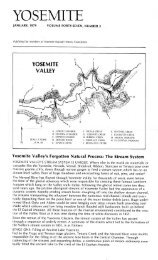
![(March 1982) [PDF] “We Are Pleased to Announce†- Yosemite Online](https://img.yumpu.com/51299748/1/190x242/march-1982-pdf-aeuroewe-are-pleased-to-announceaeur-yosemite-online.jpg?quality=85)
![[PDF] Old Horny, Yosemite's Unicorn Buck - Yosemite Online](https://img.yumpu.com/51269869/1/184x260/pdf-old-horny-yosemites-unicorn-buck-yosemite-online.jpg?quality=85)
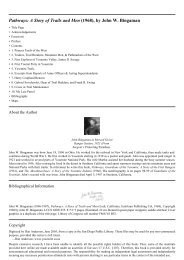
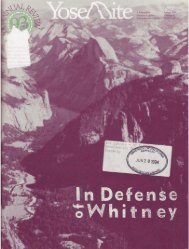
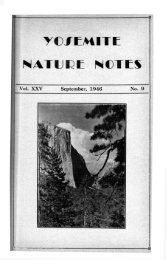
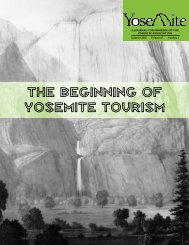
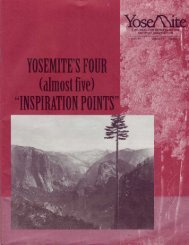
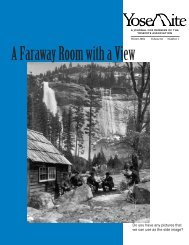
![1985 [PDF] - Yosemite](https://img.yumpu.com/48128837/1/184x260/1985-pdf-yosemite.jpg?quality=85)

